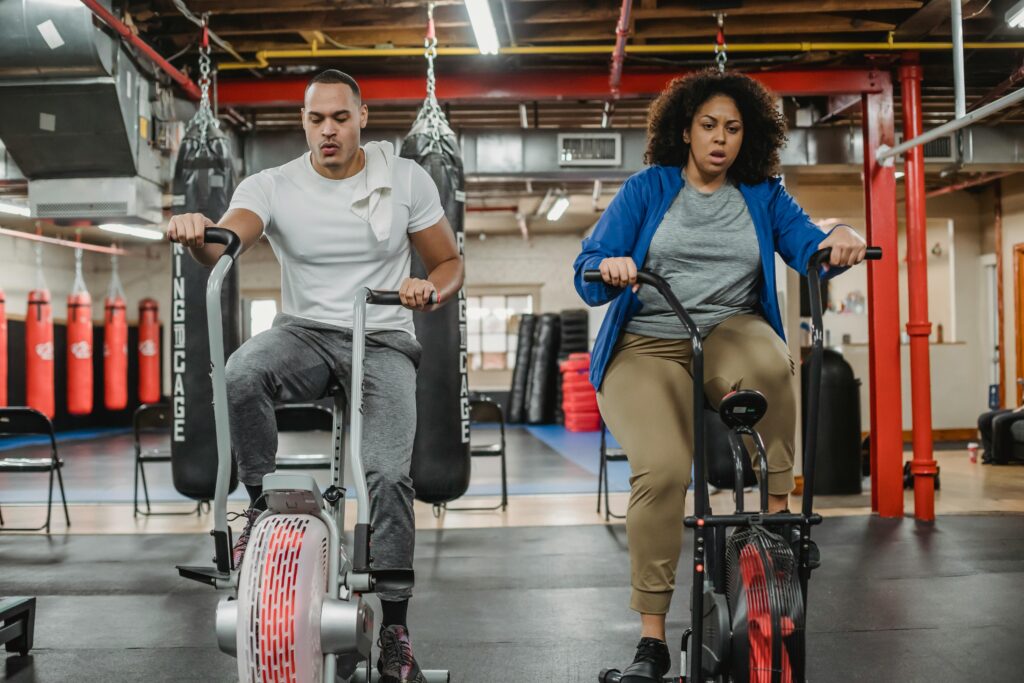It is essential to know how to make a bike stationary to enable effective indoor training, which is crucial for maintaining fitness regardless of external conditions. This skill allows cycling enthusiasts to continue their training routines without being affected by weather, daylight, or location constraints.
It involves transforming a regular bicycle into a static exercise machine, enabling indoor training regardless of weather conditions or time constraints. Stationary biking offers numerous benefits, including cardiovascular health, muscle toning, and weight management, all while avoiding the risks associated with outdoor cycling.
By converting a conventional bike into a stationary one, you gain the flexibility to engage in a structured exercise routine at your convenience. This guide will teach you how to make a bike stationary with step-by-step instructions.
What Is a Stationary Bike?
Also known as an exercise bike, this is a piece of fitness equipment designed for indoor cycling. It simulates the experience of riding a bicycle but remains fixed in one place. Key components include a saddle, pedals, and handlebars, similar to a traditional bike, along with a flywheel or magnetic resistance system to adjust workout intensity.

Many models feature digital displays to monitor speed, distance, time, and sometimes heart rate. Stationary bikes are popular for cardiovascular workouts, helping to improve stamina, burn calories, and strengthen leg muscles.
They are widely used in gyms, homes, and rehabilitation centers due to their low-impact nature, making them suitable for various fitness levels and ages. Stationary bikes offer a convenient way to exercise regardless of weather conditions or outdoor cycling availability.
Understanding how to make a bike stationary for exercise is beneficial for those wanting to maintain their cycling routine indoors. In this guide, we will help you learn how to make a stationary bike from a bicycle by using specific equipment or methods.
Types of Stationary Bikes
Stationary bikes come in various forms, each tailored to different fitness needs and preferences.
1. Trainer Bikes
These are the traditional stationary bikes commonly found in gyms and homes. They come with adjustable resistance levels and often feature digital displays to track workout metrics like distance, time, and calories burned.

2. Roller Bikes
Also known as spin bikes, these simulate outdoor cycling experiences. They typically have a heavier flywheel for smoother pedaling and allow users to adjust resistance levels to mimic uphill climbs or sprints. They are popular for high-intensity interval training (HIIT) and provide an effective cardiovascular workout.

Both types offer low-impact exercise options suitable for individuals of various fitness levels. When choosing between them, consider factors such as comfort, resistance options, and the type of workout experience you prefer.
In this guide, you will learn how to turn a bike into a stationary bike without trainer, seeking cost-effective solutions.
Choosing the Right Bicycle
When considering how to turn your bike into a stationary workout bike, choosing the right bicycle is important. Below are the factors to consider when selecting a bike for conversion.
- Frame Sturdiness: Opt for a bicycle with a sturdy frame that can withstand the rigors of stationary use. Steel or aluminum frames are typically robust choices.
- Compatibility: Ensure the bicycle is compatible with stationary bike conversion kits or stands. Look for a frame design that allows for easy attachment and stability.
- Bike Type: Various types of bicycles can be converted into stationary bikes, including road bikes, mountain bikes, and hybrid bikes. Choose one that suits your preferences and exercise goals.
- Size and Fit: Select a bike that fits your body size comfortably. Proper bike fit is essential for comfort and preventing injury during stationary workouts.
- Condition: Assess the condition of the bike, checking for any signs of wear or damage. A well-maintained bike will ensure a smoother and safer stationary cycling experience.
- Budget: Consider your budget when selecting a bike for conversion. While high-end bikes offer advanced features, a mid-range or used bike can also be a cost-effective option.
What You’ll Need to Turn Your Bike Into A Stationary Bike
To convert your bike into a stationary exercise machine, you’ll need essential equipment:
- Bike Trainer or Stationary Bike Stand: This apparatus holds your bike steady and provides resistance for indoor cycling workouts.
- Bike Wheel Riser Block: Placed beneath the front wheel, it ensures your bike remains level during stationary rides, enhancing stability and comfort.
- Bike Speed and Cadence Sensor: Although optional, installing this sensor allows you to monitor key workout metrics like speed and cadence, enhancing your training experience.
- Mat or Rug for Floor Protection: Protect your floor from scratches and sweat by placing a mat or rug beneath your bike, minimizing damage and providing a stable surface.
How to Make a Bike Stationary?
Now, let’s discuss how to make a bicycle a stationary bike with simple steps and essential accessories. Whether it’s transforming your bike or making your own, learn how to turn your bike into a stationary workout bike to enjoy indoor cycling workouts anytime.
Here is a step-by-step guide on how to make a bike a stationary bike.
1. Setting Up Your Bike Trainer or Stand
The first step is setting up your bike trainer or stand. This involves securing the stand or trainer on a stable surface and adjusting it to fit your bike securely. Ensuring stability and safety during setup is paramount to prevent accidents or damage to your equipment.

2. Using a Wheel Riser Block
A wheel riser block is essential for maintaining the correct positioning of your bike during stationary workouts. Positioning the riser block correctly beneath the front wheel helps simulate a natural riding position and ensures proper alignment with the trainer or stand.
3. Adding a Speed and Cadence Sensor (Optional)
For those looking to track their workouts more accurately, adding a speed and cadence sensor can be beneficial. These sensors provide valuable data for monitoring your progress and can be easily installed on your bike.

Pairing the sensor with fitness apps or devices allows for seamless integration into your workout routine.
4. Creating a Comfortable Workout Space
Dedicating a specific area for your bicycle is key to creating a comfortable and motivating workout environment. Consider factors such as ventilation and hydration to optimize your workout space and enhance your overall experience.
5. Additional Modifications
To further enhance your bicycle setup, explore optional accessories such as handlebar grips, seat cushions, or even a tablet holder for entertainment during workouts. Customizing your bike to suit your preferences can significantly improve comfort and efficiency during exercise.
Maintenance and Care
To turn your bike into a stationary bike, routine maintenance is key to ensuring its longevity and optimal performance. Regularly inspecting the bike’s components, such as the frame, pedals, and resistance mechanism, can help identify any potential issues early on.

Cleaning the bike after each use to remove sweat and dirt buildup prevents corrosion and keeps the equipment in top condition. Lubricating moving parts like the chain and pedals reduces friction, ensuring smooth operation during workouts.
By prioritizing maintenance and care, you can make your bike a reliable and durable stationary exercise machine that provides an effective workout every time.
Training Tips and Exercises
Once you’ve learned how to turn your bike into a stationary bike and have completed the process, it’s time to explore various training programs and exercises to maximize your workout potential.

Incorporating interval training, hill climbs, and endurance rides into your routine can target different muscle groups and improve cardiovascular fitness. Utilizing a smart indoor bike setup allows you to track your progress and stay motivated by setting achievable goals.
Experiment with different workouts to keep your sessions interesting and challenging, and don’t forget to monitor your performance to gauge improvements over time. With dedication and consistency, your homemade stationary bike can become a powerful tool for achieving your fitness goals.
Conclusion
Knowing how to make a bike stationary is fundamental for any cyclist. Whether you opt for a professional stand or a DIY solution, bike stability is achievable with the right approach and equipment.
Moreover, creating a comfortable workout space and considering additional modifications further enhance the bicycle setup. By following the step-by-step guide provided, cyclists can confidently transform their regular bicycles into stationary exercise machines.
If you’re looking for a high-tech option, you can further explore how to build your own smart indoor bike or how to build your own smart cycle on the cheap. Remember, a stationary bike is not just a tool for stability but also a symbol of responsible bike ownership and care.
FAQs
Yes, you can convert a mountain bike into a stationary bike using a bike trainer or a dedicated stationary stand.
Yes, using a stationary bike regularly can help reduce belly fat by burning calories and boosting overall fat loss.
Stationary biking can be easier or harder than outdoor biking depending on resistance settings and workout intensity.
Yes, cycling can replace gym workouts by providing excellent cardiovascular and strength training benefits.



